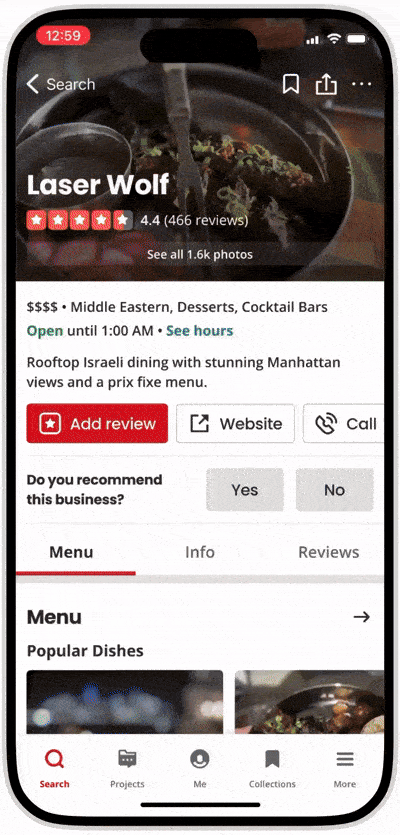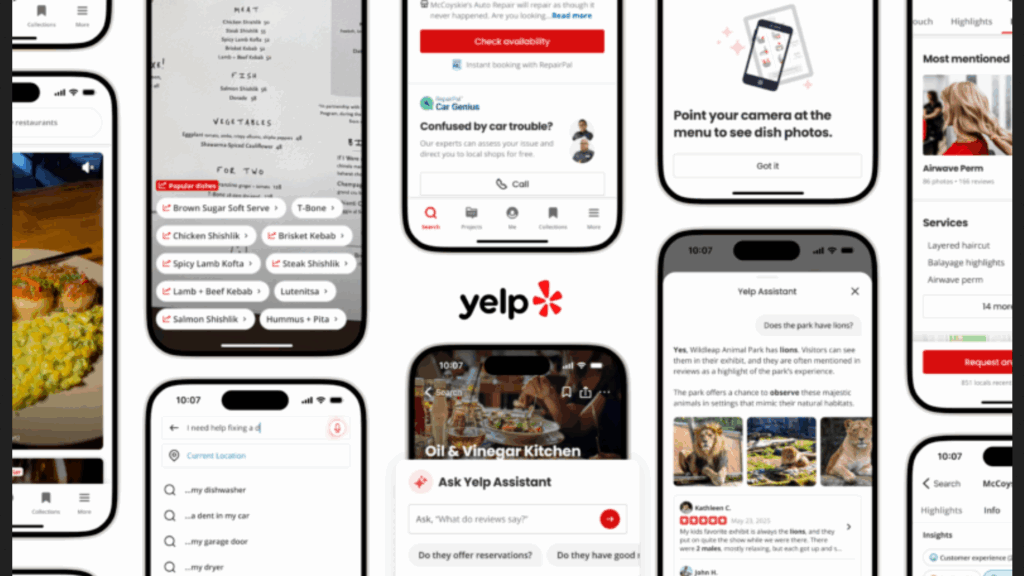- Yelp’s new AI Assistant now answers detailed user questions
- The AI can interact through text or voice and use a new feature called Menu Vision
- The impact of more AI on Yelp remains to be seen
The enhanced assistant is available on Yelp’s mobile apps. You can ask any question you may have in your own words via text or search with your voice. If you’re at a restaurant and want to know what the menu description translates to in real life, you can give Yelp’s new Menu Vision feature access to your camera and it will find pictures of the food.
But while the move is newsworthy for what it adds to Yelp’s ecosystem, it’s just as interesting for what it could mean for how people use Yelp. After all, Yelp built its brand on crowdsourced opinion. Deep dives into a sushi restaurant’s unique lighting plan, brunch disasters, thoughtful, heartfelt praise for specific servers, and other messy, honest, wildly uneven stories were the point. You may have to sift through noise to find a reliable signal, but the noise added depth and color to the responses.
Wrapping the human scatter into the streamlined AI seems to remove all that flavor text. Yelp describes AI’s neat, well-referenced answers not as erasing the human element, but simply as translations into more accessible forms.
Yelp’s AI doesn’t generate answers out of thin air. It draws on its community’s mountain of data: review text, tagged photos, user preferences and business listings. This means that it still depends on humans to operate the machine. But if the assistant becomes the default interface, it’s easy to imagine users no longer feeling compelled to write their own epic consumer stories.
Human Yelps
This dual-front AI rollout places Yelp somewhere between Google Maps and a full-scale digital concierge. Menu Vision is a good example of the change. You are out to eat. You point your phone at the menu. Like magic, the AI overlays real dish images, prices and reviews for that particular dish without the need to search or scroll through traditional reviews.
You’re not reading someone’s full impression of a meal, just a polished thumbnail of collective feelings. But you can just as easily look at the star ratings or do a keyword search if that’s what you want.
Yelp’s AI upgrades appear to be based on the idea that most users would rather have a quick, visual summary than wade through 47 conflicting reviews. And they may be right in most cases. If Yelp once felt like a browseable user experience bazaar, the new version wants to feel like a direct line to someone who already knows what you want.

Yelp’s moves are well known as part of a broader trend sweeping through consumer apps. Platforms that were once centered on human-produced content are repackaging them with AI designed for speed. It’s visible from forums like Stack Overflow to Amazon’s e-commerce hub, not to mention Google’s blitz to make AI ubiquitous across all their products. Yelp has lots of data, which makes it more immediately useful (and easier to monetize) make sense.
For most users, this will be a good thing. You’ll spend less time staring at star ratings and more time finding a place that’s actually good. You get faster recommendations, better booking flows and less guesswork
But it’s doubtful that the elements that make Yelp’s data valuable will still roll in without the messy bits. Would as many people write the helpful, if brutally scathing reviews, contribute to the Assistant’s responses if no one wants to look past the AI to read them? The assistant’s answer cites their sources so you can dig back to the original review if you want, but how many choose to do that?
But for those diehards who loved the thrill and serendipity of stumbling upon that one brilliant, bizarre, overlong review, Yelp’s new AI layer can feel like a boring straight path past an enticing wilderness. This could be the future of discovering local businesses, but you’ll have to hope the food at the restaurants it recommends isn’t as bland as the answer to your question.
Follow TechRadar on Google News and add us as a preferred source to get our expert news, reviews and opinions in your feeds. Be sure to click the Follow button!
And of course you can too follow TechRadar on TikTok for news, reviews, video unboxings, and get regular updates from us on WhatsApp also.



